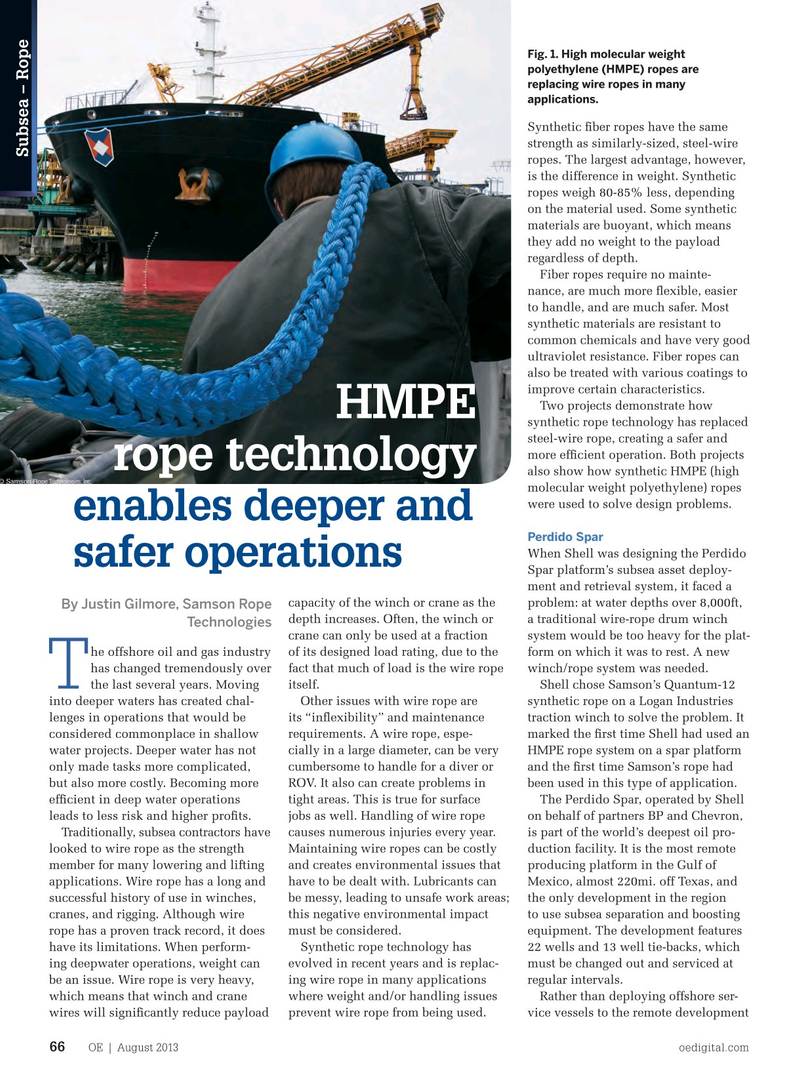
Page 64: of Offshore Engineer Magazine (Aug/Sep 2013)
Read this page in Pdf, Flash or Html5 edition of Aug/Sep 2013 Offshore Engineer Magazine
Fig. 1. High molecular weight polyethylene (HMPE) ropes are replacing wire ropes in many applications.
Synthetic fber ropes have the same strength as similarly-sized, steel-wire
Subsea – Rope ropes. The largest advantage, however, is the difference in weight. Synthetic ropes weigh 80-85% less, depending on the material used. Some synthetic materials are buoyant, which means they add no weight to the payload regardless of depth.
Fiber ropes require no mainte- nance, are much more fexible, easier to handle, and are much safer. Most synthetic materials are resistant to common chemicals and have very good ultraviolet resistance. Fiber ropes can also be treated with various coatings to improve certain characteristics.
Two projects demonstrate how
HMPE synthetic rope technology has replaced steel-wire rope, creating a safer and more effcient operation. Both projects rope technology also show how synthetic HMPE (high molecular weight polyethylene) ropes were used to solve design problems.
enables deeper and
Perdido Spar
When Shell was designing the Perdido safer operations
Spar platform’s subsea asset deploy- ment and retrieval system, it faced a capacity of the winch or crane as the problem: at water depths over 8,000ft,
By Justin Gilmore, Samson Rope depth increases. Often, the winch or a traditional wire-rope drum winch
Technologies crane can only be used at a fraction system would be too heavy for the plat- he offshore oil and gas industry of its designed load rating, due to the form on which it was to rest. A new has changed tremendously over fact that much of load is the wire rope winch/rope system was needed.
the last several years. Moving itself. Shell chose Samson’s Quantum-12
T into deeper waters has created chal- Other issues with wire rope are synthetic rope on a Logan Industries lenges in operations that would be its “infexibility” and maintenance traction winch to solve the problem. It considered commonplace in shallow requirements. A wire rope, espe- marked the frst time Shell had used an water projects. Deeper water has not cially in a large diameter, can be very HMPE rope system on a spar platform only made tasks more complicated, cumbersome to handle for a diver or and the frst time Samson’s rope had but also more costly. Becoming more ROV. It also can create problems in been used in this type of application.
effcient in deep water operations tight areas. This is true for surface The Perdido Spar, operated by Shell leads to less risk and higher profts. jobs as well. Handling of wire rope on behalf of partners BP and Chevron,
Traditionally, subsea contractors have causes numerous injuries every year. is part of the world’s deepest oil pro- looked to wire rope as the strength Maintaining wire ropes can be costly duction facility. It is the most remote member for many lowering and lifting and creates environmental issues that producing platform in the Gulf of applications. Wire rope has a long and have to be dealt with. Lubricants can Mexico, almost 220mi. off Texas, and successful history of use in winches, be messy, leading to unsafe work areas; the only development in the region cranes, and rigging. Although wire this negative environmental impact to use subsea separation and boosting rope has a proven track record, it does must be considered. equipment. The development features have its limitations. When perform- Synthetic rope technology has 22 wells and 13 well tie-backs, which ing deepwater operations, weight can evolved in recent years and is replac- must be changed out and serviced at be an issue. Wire rope is very heavy, ing wire rope in many applications regular intervals.
which means that winch and crane where weight and/or handling issues Rather than deploying offshore ser- wires will signifcantly reduce payload prevent wire rope from being used. vice vessels to the remote development
OE | August 2013 oedigital.com 66 066_OE0813_Subsea2_Rope.indd 66 7/22/13 12:53 AM

 63
63

 65
65